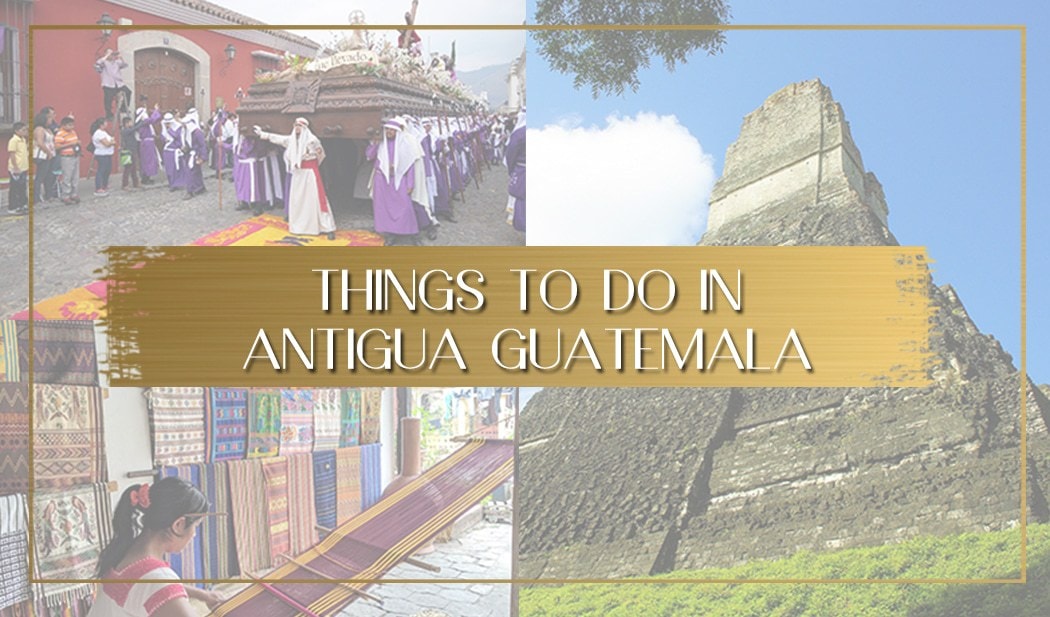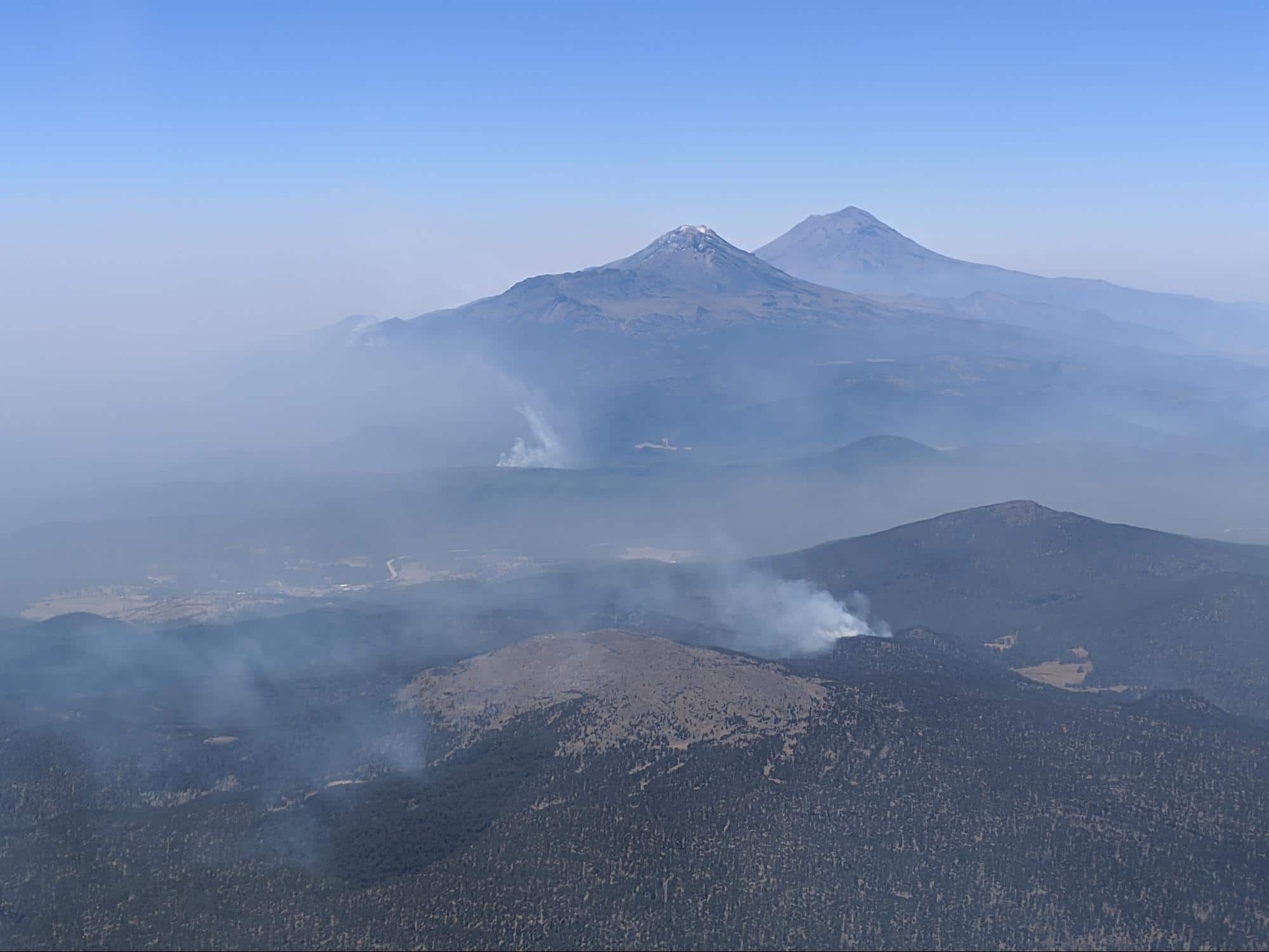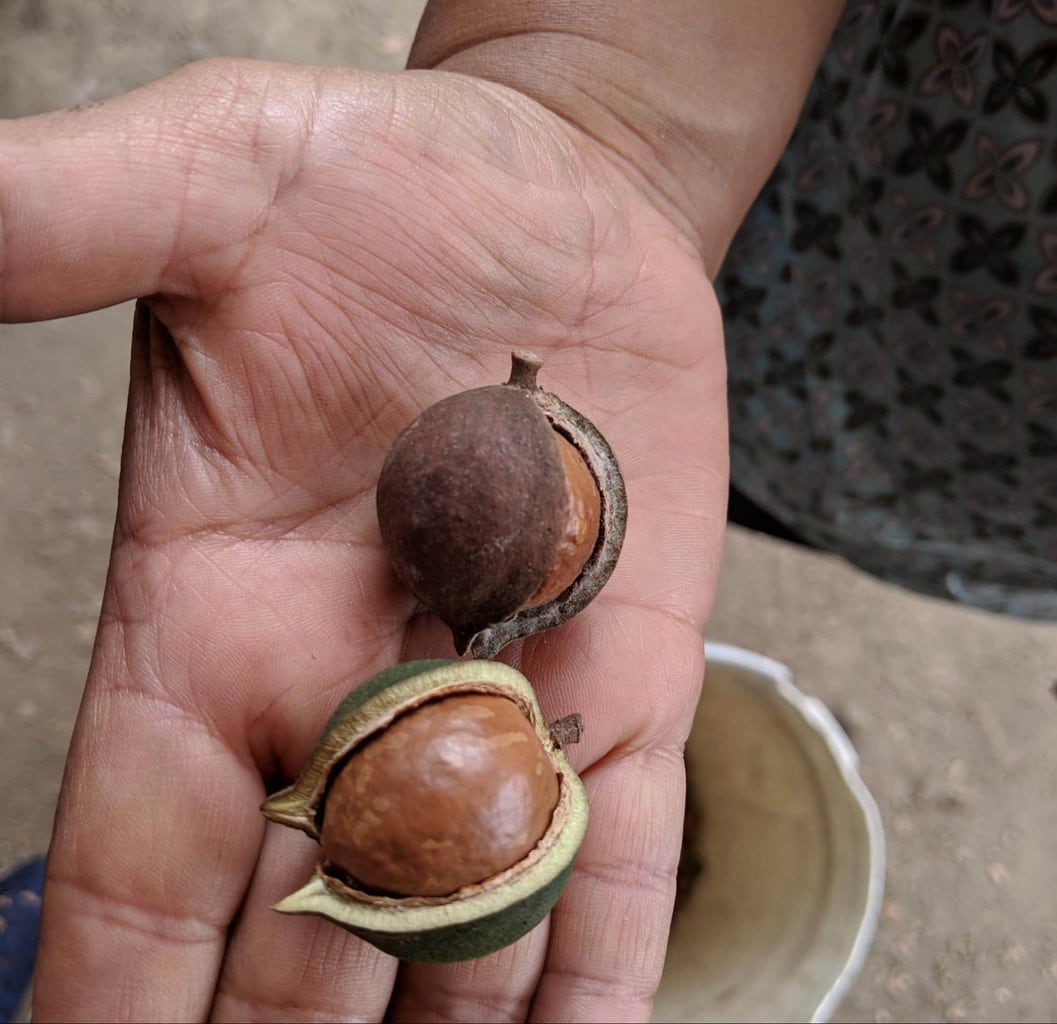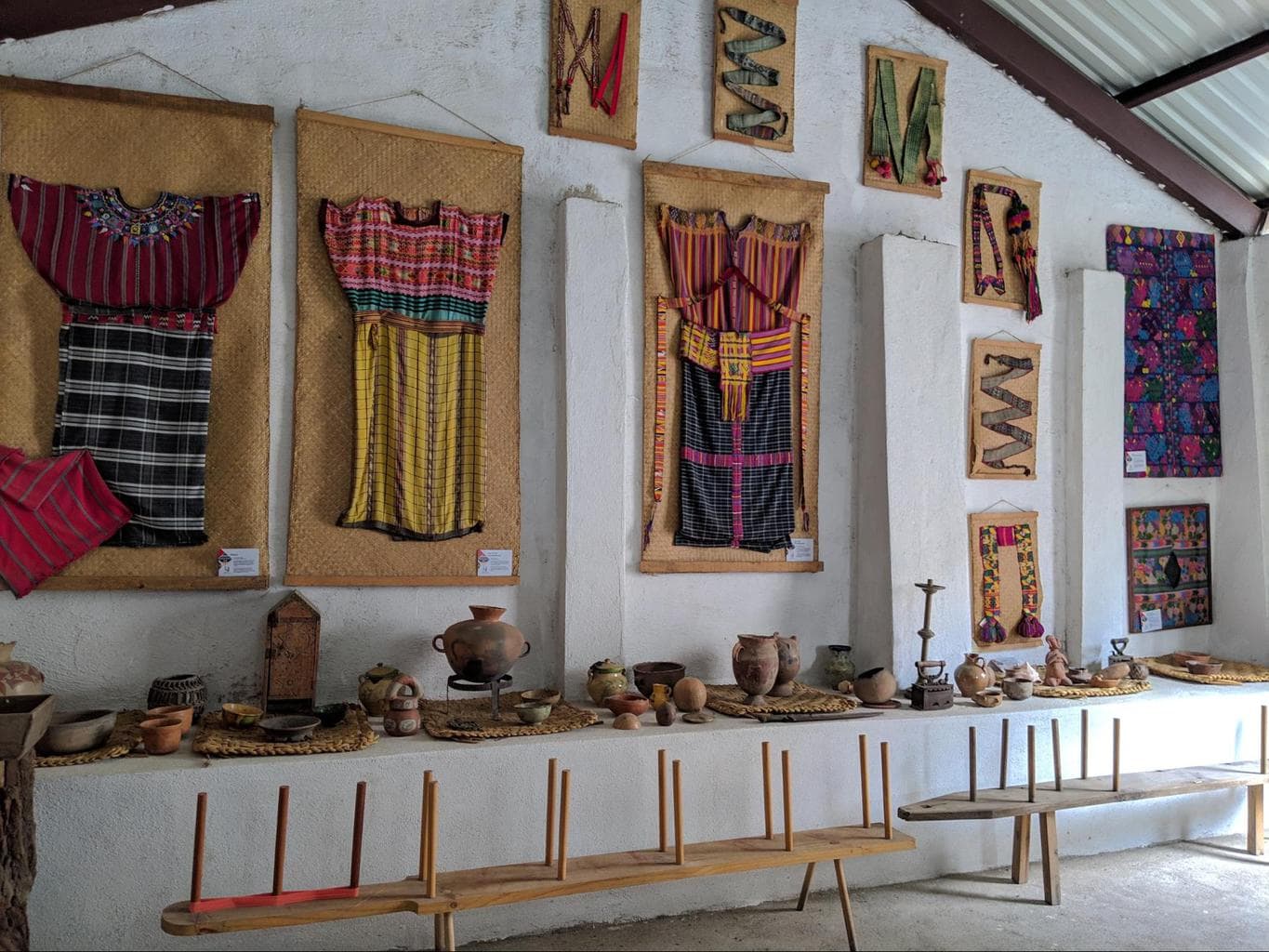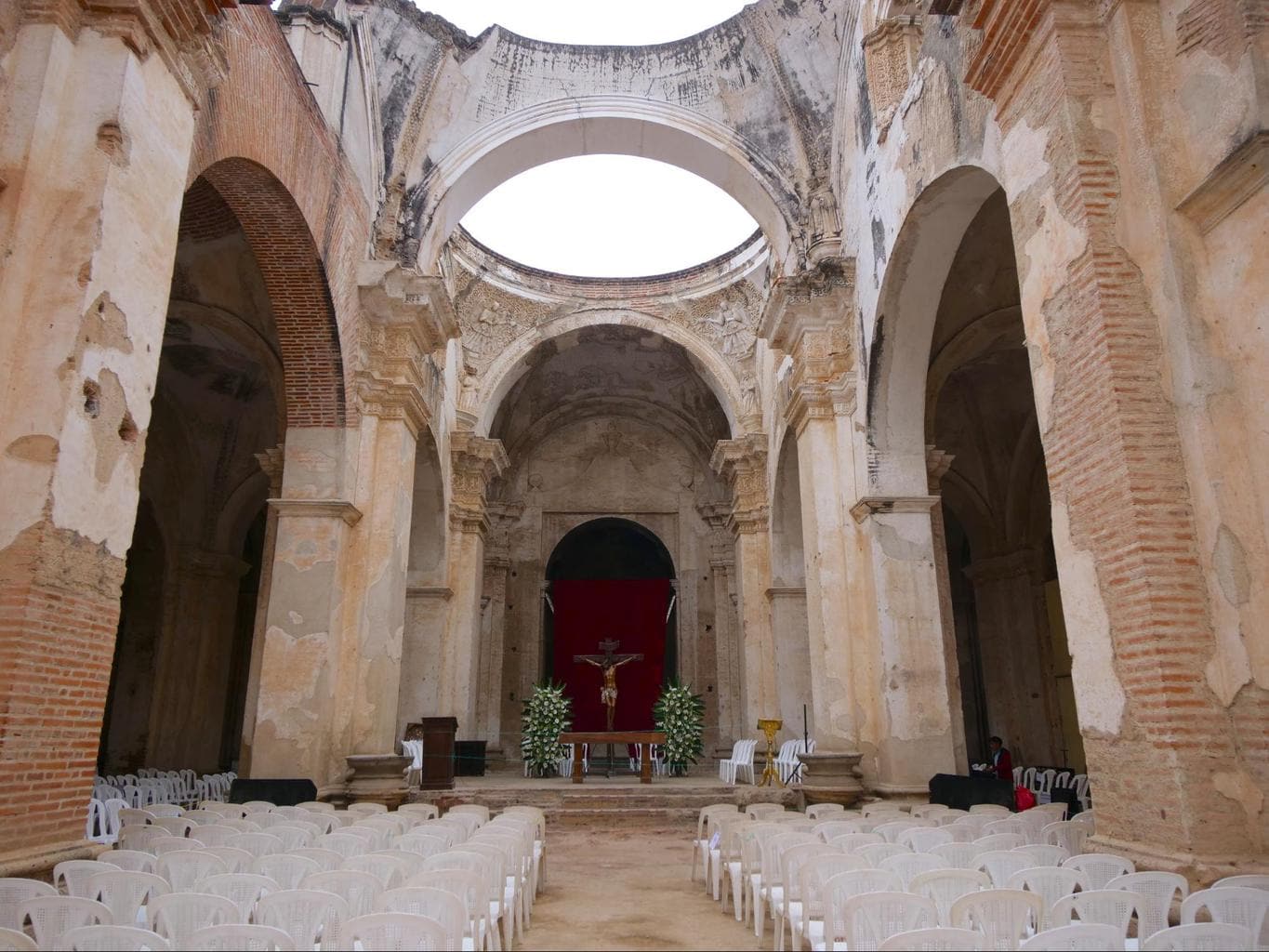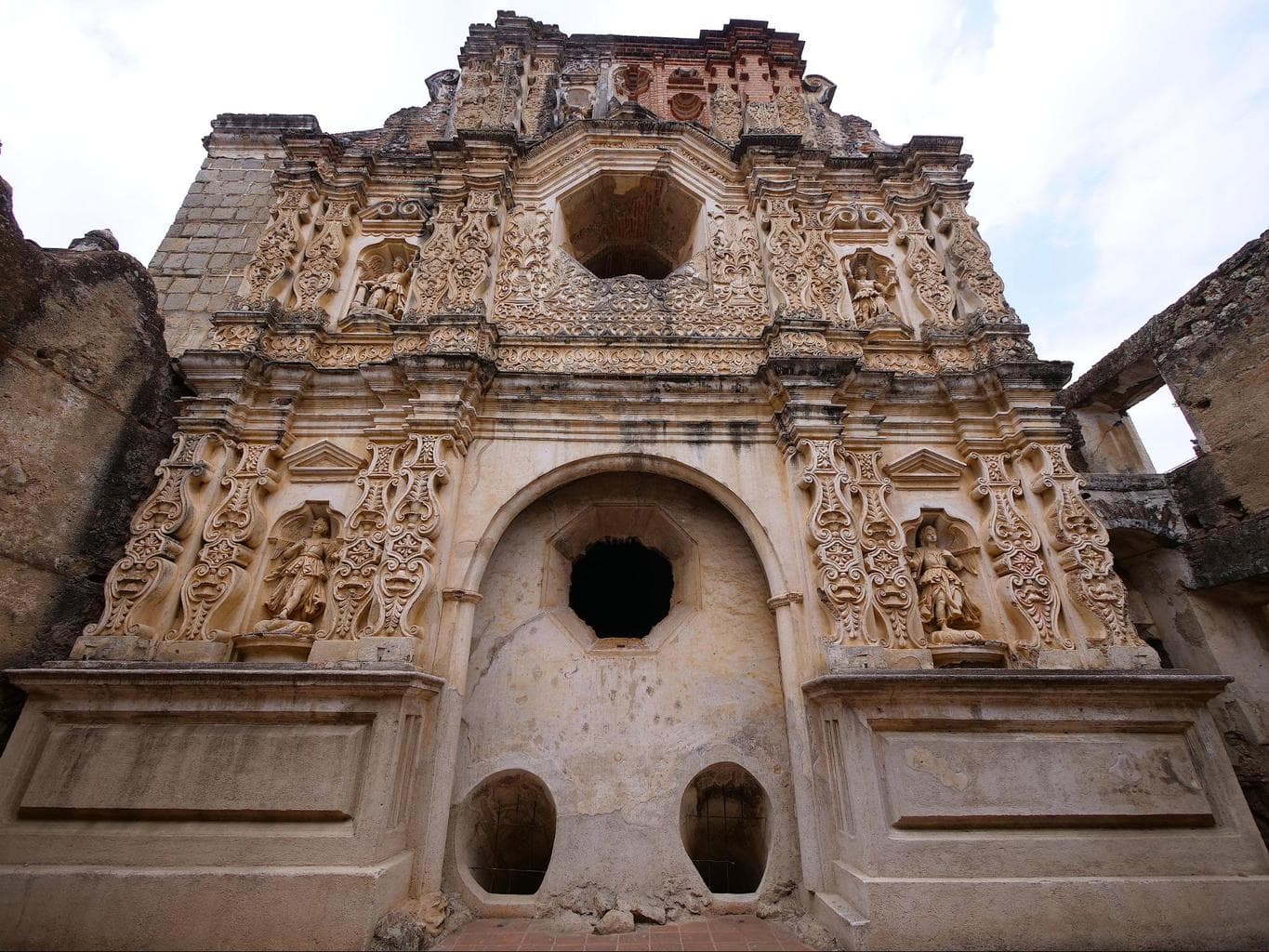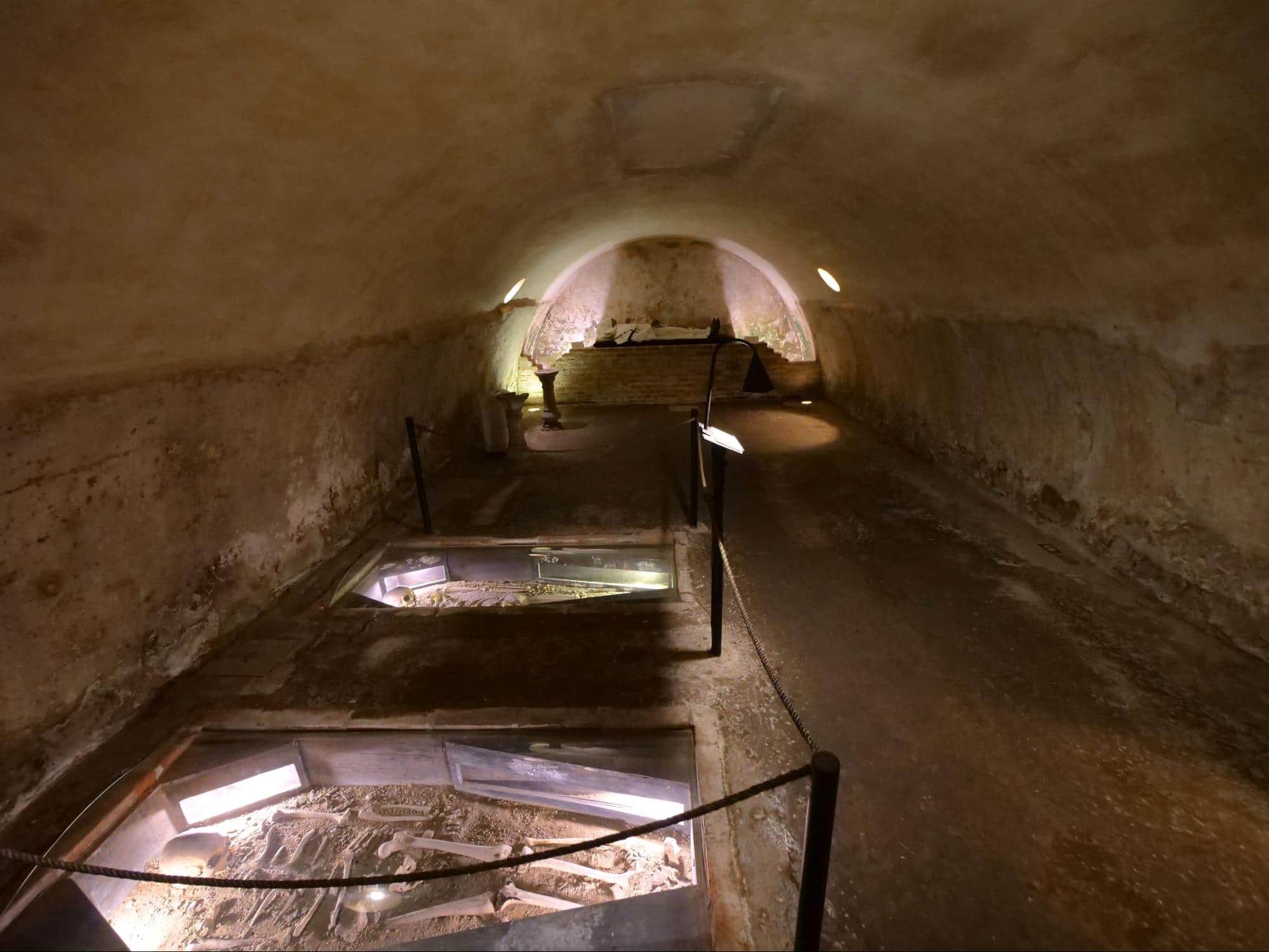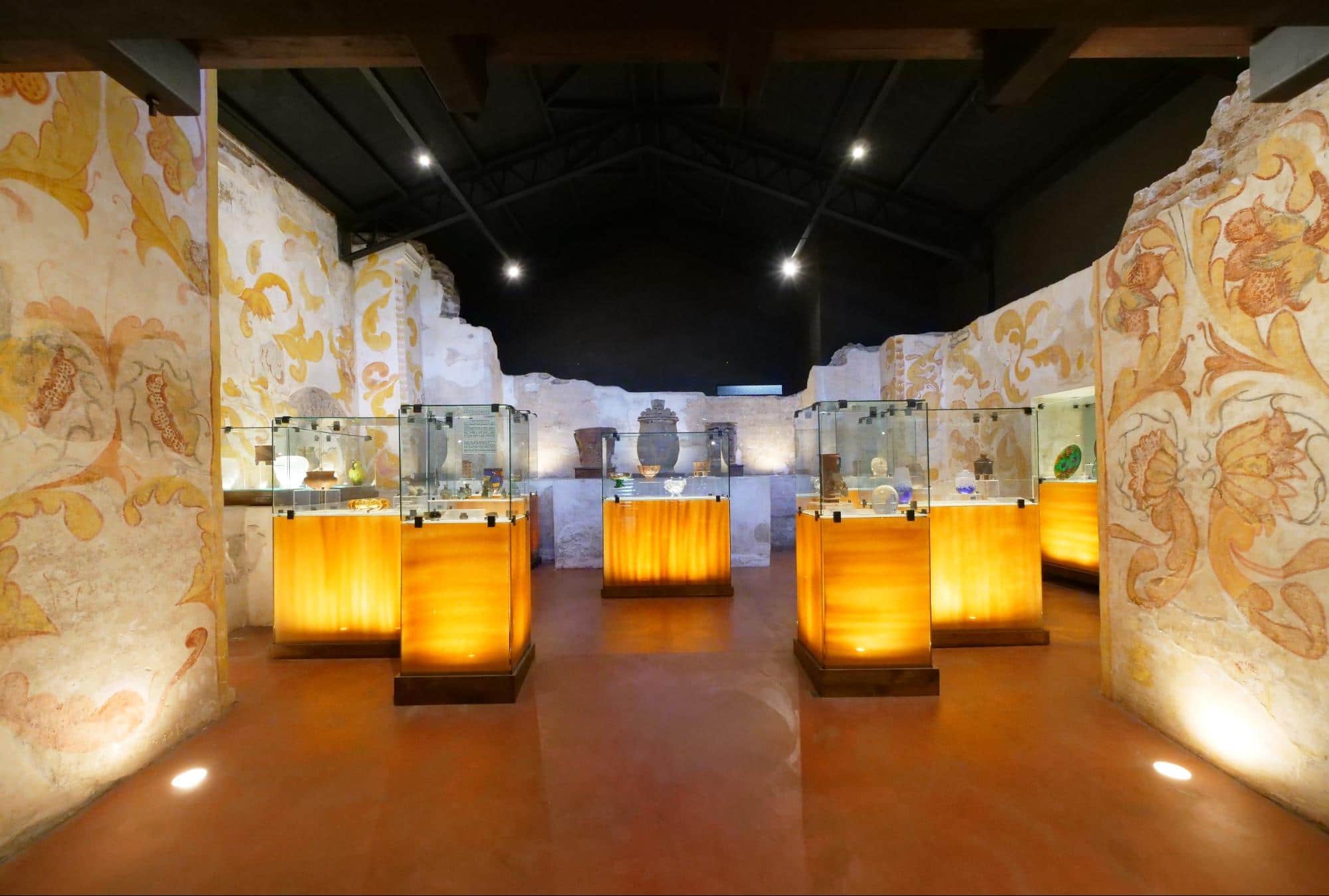Antigua Guatemala is the most beautiful city in the country and the center of Spanish architecture, volcanoes and heritage.
It is also the most popular place to visit in Guatemala and almost every single one of the visitors to the country will spend a few days there or at least come on a day trip.
Despite having seen lots of pictures of the yellow arch that makes Antigua Guatemala so famous, before visiting I didn’t know much more about Antigua Guatemala. Online searches often returned a lot more about Antigua the island than the colonial city in Guatemala.
So what to do in Antigua Guatemala?
Plenty!
Antigua Guatemala was the Spanish colonial capital until it was destroyed by an earthquake at the end of the 18th century and much of what was left afterwards is still there with minimal reconstruction.
Today, Antigua Guatemala is a UNESCO-listed city with a thriving chocolate and coffee culture, an artistic vibe and a heritage-rich past which can be explored through the many convents, churches and important landmarks.
History of Antigua Guatemala
One cannot travel to Antigua Guatemala without first understanding a bit of its history because it is paramount to understanding why it looks like it does and its importance to the country’s past.
Guatemala is a multicultural country with the slogan “The heart of the Mayan culture” and this is obvious from the moment you step into the country.
The Mayan make up for half of the population of Guatemala and while the official language is Spanish, there are several others being spoken, most notably 23 different Mayan dialects.
The word Guatemala was first coined by Spainish Conquistador Pedro de Albarado, in a letter he sent to Hernan Cortes in 1524, and while there are many possible origins for the word, the most commonly accepted translates as “the place of forests” and it referred to Iximche.
The capital of colonial Guatemala changed three times through the Spanish occupation but it started in Iximche, today Tecpan, the first settlement to be conquered by Pedro de Albarado when he arrived in Guatemala from Tenochtitlan, Mexico.
The city was named Santiago after the Apostle but because of the constant uprisings, it was moved to Ciudad Vieja in 1527.
Unfortunately, Ciudad Vieja was destroyed by a mudslide from Volcan de Agua in 1541 so the capital had to be moved once again to today’s Antigua Guatemala, then known as Santiago de los Caballeros de Guatemala, City of Saint James of the Knights of Guatemala.
Santiago de Guatemala was located in a valley, at 1,500m above sea level, and flanked by mountains, hills and three imposing volcanoes, two of which are still active.
But Antigua Guatemala did not last long either as the capital because it was hit by many earthquakes with the final stroke handed in 1773 by an earthquake known as Santa Marta which caused widespread damage and the collapse of most of its buildings.
The majority of the population left Antigua Guatemala then and the capital was moved to Guatemala City, where it has remained until today.
But not everyone left.
Some of the convents and churches remained occupied and renovation work was carried out by nuns and monks. However, the city was struck by several other earthquakes which only worsened the destruction.
Antigua Guatemala was practically and completely abandoned after the 1874 earthquake. Locals started to return in the second half of the 20th century and UNESCO recognised it as Humanity’s World Heritage site in 1979.
Since then, reconstruction efforts have been ongoing but the city remains a large archeological site with most of its buildings still in ruins and does not even have half of the population it had in the 18th century.
Architectural style of Antigua Guatemala
Because the majority of the constructions in Antigua Guatemala were done during the 17th century and then reconstructed in the 18th, the dominant architectural style is Baroque.
The colonial Baroque style of religious buildings found across Central America and Guatemala in particular, is characterised by imposing facades painted in the typical straw yellow with white stucco decorations, religious statues, low bell towers and vertical columns.
Inside, convents are square in shape, with cloisters set around fountains, and lots of gardens. Churches are rectangular. Fountains are also found across the city, in squares and private buildings.
Later religious constructions done after the 1717 earthquake evolved into lower and thicker walls that look like fortifications and which were designed to better withstand earthquakes.
Private homes are today painted in bright colors, like the ones found in the colonial villages of El Salvador, along La Ruta de las Flores or Suchitoto, which make for pretty pictures.
The streets of Antigua Guatemala are cobblestoned and have been preserved since its first construction giving the city a truly mystical feel.
Antigua or Antigua Guatemala?
By now you may have realised that the city’s name is not Antigua, but La Antigua Guatemala or Antigua Guatemala, which translates from Spanish to The Former Guatemala, The Old Guatemala or The Ancient Guatemala.
We tend to shorten the city’s name from Antigua Guatemala to just Antigua or La Antigua, but the official and true name is La Antigua Guatemala, which also differentiates it from Guatemala City whose official name is Nueva Guatemala de la Asunción, or New Guatemala of the Assumption.
As the name suggests, this was the former capital of Guatemala, as you read above, which is why this name was only coined after the capital was moved to today’s Guatemala City to differentiate it from the new Guatemala.
Things to do in Antigua Guatemala
The city is a pretty active place to visit and there are a lot of things to do in Antigua Guatemala in a variety of areas, from nature to volcanoes, cultural sights and even chocolate and coffee, two of my most favorite things.
Go shopping
One of the best things to do in Antigua Guatemala is go shopping for beautifully colorful textiles and souvenirs to take home. The Mayans truly mastered the art of sewing and weaving and the brightly colored clothes they wear are testimony to this great skill.
There are a few places to shop in Antigua Guatemala but I wanted to highlight two where you will surely find what you need.
Mercado de Artesanias El Carmen


One of the most convenient places to shop in Antigua is the Mercado de Artesanias El Carmen, a hidden maze of stores near the ruins of El Carmen Church.
From the outside it does not look like much but walk in and you will be surprised by a space filled with objects floor to ceiling, from clothing to wallets, bags and keyrings, blankets and coveralls.
Nim Po’t

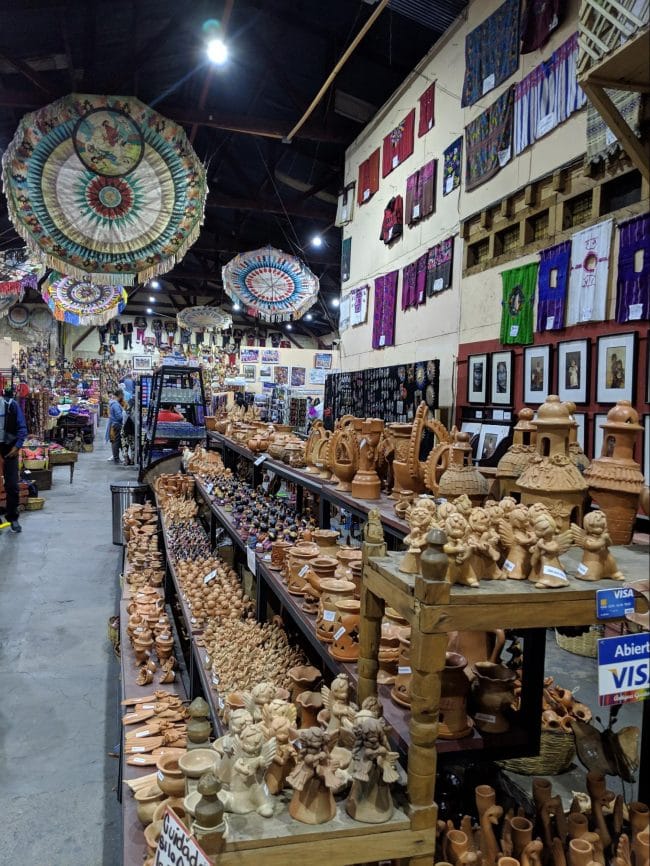
This large store right behind the arch is a place to find everything and anything organised by theme in an incredibly large space.
From photographs to masks, from fridge magnets to chilli sauce, Nim Po’t has every single souvenir produced by local artisans under one roof.
No bargaining here, prices are fixed but they are also reasonable, and you can pay by credit card. More information here.
Learn about Jade stones
La Casa del Jade is actually a jade store but the staff are nice and welcoming and you can learn about jade stones and the specifically Guatemalan purple color jade that is only found here.
The main store is in a stunning colonial building with the jewelry on display around the main courtyard and in the many adjacent rooms. There is also a museum with original pieces as well as reconstructions of stunning Mayan items.
The Mayans prized jade and made masks and jewelry from it, often times buried their dead with the valuable items. These objects were forgotten and started to be found with the archeological works that kicked off in the 70s.
I will admit that I ended up buying a nice pair of earrings there but found the explanations to be very useful and the staff was not at all salesy.
More information here.
Share a refined dinner at Panza Verde
Guatemalan food is pretty good and has a few dishes which I totally loved, but the regular eating style is quite casual and laid back. If you wanted to have a romantic or refined evening, Meson Panza Verde is a nice restaurant located in a boutique hotel in the southern part of town.
The menu includes the typical local dishes but also international options and the setting is beautiful with tables spread around an inner, open air courtyard.
Make your own chocolates
Pre-Columbian cultures all considered chocolate the food of the Gods. The word cacao comes from the Toltec ka-ka-w and the fruit was considered currency at the time and it was also used for ceremonies.
With the arrival of the Spanish cacao was first exported to Europe and sugar and milk were added for flavor. From then on, cacao made its way everywhere else and its cultivation expanded.
Today, like coffee, cacao is a major commodity that is experiencing a revival in Guatemala.
In Antigua Guatemala you can learn how to make your own chocolates from bean to the table or take a chocolate workshop at Chocomuseo.
Chocomuseo is an international company with locations across Latin America and a conveniently located store near the Arch.
The store-museum has a section where you can read all about the origin of the cocoa beans and its evolution until today’s consumption, enjoy an ice cream, buy some chocolates, have a hot chocolate at the cafe or buy a pot of the local version of Nutella (Guatella) made with peanuts and no palm oil.
You can also sign up for your own chocolate making workshop and learn how to roast and process the beans and also try the chocolate drink the Mayan prepared (spoiler: not as tasty as our version!).
Or better yet, learn how to make truffles. Younger ones can join one of their children’s workshops. Tours last about a couple of hours you can pick your chocolates up an hour later (they need to cool down first).
This is also a great place to buy souvenirs, trust me, anyone will love to get some Guatemalan chocolate. More information here.
Pay your respects at Iglesia de la Merced, La Merced Church
This straw yellow church and convent located behind the famous Arch in Antigua Guatemala is the oldest in the city and possibly the most important. It is also the one with the most information signs, even with English translations.
Iglesia de la Merced is today one of the better preserved churches in the city thanks to its thicker and lower walls and a must visit tourist attraction in Antigua Guatemala.
It opened in 1546 but has been renovated and expanded several times because of the many earthquakes. The sanctuary and convent were built in 1767 and partially damaged by the 1773 earthquake but subsequently reconstructed.
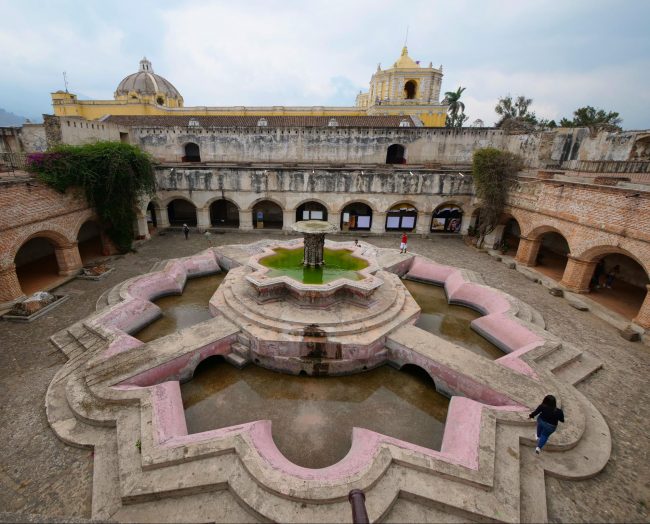

Today, only the church is in use. Its intricately designed yellow and white stucco Baroque facade flanked by two square towers is still standing although not all the statues that were once there still exist. This is the finest facade of all churches in Antigua Guatemala.
The cloister has the largest fountain in Antigua Guatemala and possibly Latin America built in the shape of a water lily, a Mayan symbol. You can look out for the poster which explains how the fountain works in an ingenious way that leverages the city’s water resources.
Like other convents in the city, it is two storeyed and offers beautiful views of the city. At the entrance, look for the Mercedarian shield on the ceiling and its references to Barcelona’s and to the Catalan flag. Merce is also the patron saint of Barcelona.
La Merced Church is home to some of the largest sculptures and palanquins used to transport the saints and virgins around the streets of Antigua Guatemala during Holy Week. When the processions are not on, the carvings are on display inside the church.
Iglesia de la Merced is part of this full day tour of Antigua Guatemala together with all the other main tourist attractions in Antigua Guatemala and a tour of the coffee plantation I mention in this article. Book it here.
See the amazing Holy Week processions
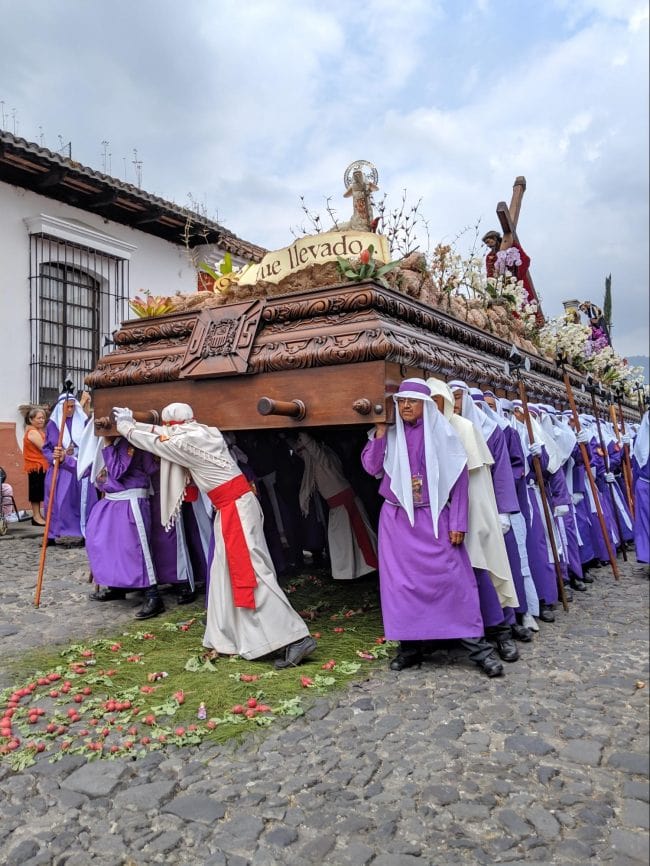

Semana Santa is the busiest and most important few weeks in Antigua Guatemala and it is one of the most amazing experiences you will ever have.
Spending a few days in the city during Easter and seeing the processions, the flower carpets and the Catholic devotion of Guatemalans is one of the most incredible things to do in Antigua Guatemala.
What happens during Semana Santa in Antigua Guatemala?
In a nutshell, Semana Santa is the most important week for the city because it is the center of Catholicism in the country. Because of its strong Spanish influence and the many churches and convents, Antigua Guatemala is where Catholicism most flourished.
Guatemalans are both Catholic and often times follow Mayan traditions and it is common to see them perform prayers and ceremonies that follow both traditions. In certain parts of the country, churches are both used for Catholic and Mayan ceremonies.
Easter commemorates the life, passion, death and resurrection of Christ and is one of the most important times of the year in the Catholic calendar after Christmas.
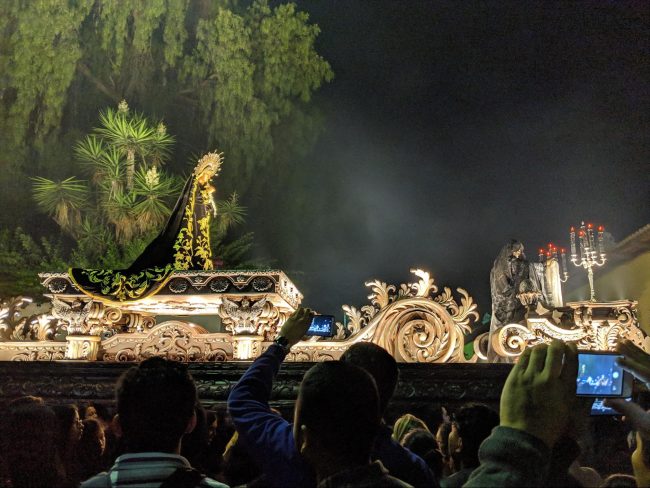

Each of the churches and convents in Antigua will take out their images of Saints and Virgins and go on a procession that can last more than 12h across the cobblestoned streets.
The palanquins they carry vary from church to church, each belonging to a cofradia, or brotherhood, with specific costumes and sculptures showcasing a moment in the Life or Death of Christ.
Some have images of Christ carrying the Cross, others carry the Virgin Mary, some are full representations of the passion of Christ and made of several individual smaller palanquins each with a scene. The largest palanquin I saw had almost 100 people carrying it, others are carried by a single person.
The majority of these brotherhoods are male, but there is a female one where all its members are women and which carries the Virgin Mary. The processions that walk behind or in front of the palanquins are usually made of entire families, children included, who will walk the streets of Guatemala through the night.
Behind every palanquin there is usually an orchestra that will play religious and rhythmic music, and the ones privileged enough to carry the palanquins will do so with their eyes closed, taking small swinging steps, side to side.
The palanquins move in unison, as if they were carried by one person only.
I am not a religious person, although I was brought up in Catholic Spain and we have our own traditions during Christmas, but I had never seen the Semana Santa processions, despite being very popular in the south of Spain, but the sights and sounds of the event impressed me.
Antiguenos, as locals from Antigua Guatemala are called, prepare for Semana Santa all year, taking care of their images, rehearsing and getting ready for this time of year.
If you want to watch the processions, it will be impossible to miss them as they cover the streets of Antigua Guatemala day and night. The largest and most important processions tend to be on Easter Friday and Sunday but they happen everyday.
Maps with the circuits and the brotherhoods that will go out everyday are available throughout the city from small tourist kiosks. Your hotel will also be able to give you more information.
What you need to know during this time of the year is that Antigua Guatemala will be really packed with every single Guatemalan coming to see or participate in the processions. The streets will be full of people, but it is not as packed as I had imagined.
You may be stuck in a street if a procession is coming, but you can always walk around it and still make your way. All you need is a bit of patience.
If you plan to go out of the city for a day excursion and then come back (like I did to go to Pacaya) make sure to check the street closures beforehand with the hotel because if the processions are passing you could be stuck in your car for hours until they are done.
Street closures will change everyday and may change more than once a day so bear that in mind. Booking a hotel that is in the outskirts of the city will also save you some trouble. I stayed at Pensativo House Hotel which was perfectly located to escape the city and had a complimentary parking lot right in front.
Enjoy brunch at Caoba Farms


Caoba Farms is a hip, eco-friendly, organic and all round feel good farm and restaurant in the southern outskirts of the city.
It is probably one of the nicest most pleasant places to have breakfast or brunch and a great destination for kids to learn more about fruits, flowers and vegetables.
The menu is made of local and international dishes such as avocado toast with the softest and tastiest avocados you have ever tried. The restaurant is set in a shaded garden with colorful signs and communal tables.
But it is not just the restaurant which makes a visit to Caoba Farm a fantastic thing to do in Antigua Guatemala but also the activities they organise.
Make sure to check their yoga classes, the butterfly garden and the area in general. There are weekend farmers markets and permaculture workshops and you can join one of the farm tours which are offered several times a day and need to be booked a day ahead.
More information here.
Climb a volcano
Guatemala is known as the land of volcanoes, like neighbouring El Salvador, so hiking a volcano is one of the most popular things to do in Antigua Guatemala.
Volcan de Agua, Acatenango Volcano and Volcan de Fuego are all visible on a clear day from Antigua but the most commonly climbed is Pacaya Volcano because it is the easiest and most approachable for the average traveler to Antigua Guatemala.
Volcan de Fuego
Volcan de Fuego measures 3,763m and is an active volcano. Its eruption in June 2018 and then in November 2018 killed more than 100 people and its name should already tell you about its aggressive eruptions.
Volcan de Agua
Volcan de Agua is 3,760m high and requires a special permit and more than a couple of days to climb. It is not an active volcano but it is not safe either with robberies commonly carried out.
Volcan de Agua is best known for the mudslide of 1541 which destroyed Guatemala’s first city and prompted the construction of Antigua Guatemala. Its name comes from the belief that there was once a lake at the top.
Acatenango Volcano
Acatenango Volcano takes about 6h to climb through a 10km long trail that ascends 1,200m up to the 3,500m top of the volcano.
The hikes to Acatenago usually mean a night spent at the top camping from where you can see Volcan de Fuego erupt in the darkness.
You have to be quite fit to get up Acatenango as the hike is much tougher than Pacaya. Book an overnight Acatenango hike here.
Pacaya Volcano
Pacaya Volcano is the easiest of all the volcanoes around Antigua to climb and it is one of the top things to do in Antigua Guatemala because it is fun. You can see lava flowing and roast marshmallows at the top.
The volcano is not completely safe but the risk is under control and, at just over 2,550m high, it is much smaller than the other three volcanoes.
Pacaya is an active volcano, that means you can see smoke, lava and rocks tumbling down from the crater almost constantly.
After being dormant for almost a century Pacaya started to erupt again in 1961 and has been active since with several fatal eruptions, the latest happening in 2014.
What makes Pacaya so popular and a great tourist attraction in Antigua Guatemala is that it is relatively easy to visit on your own or with a tour (there are several companies offering daily departures) and you don’t need special equipment or fitness levels to make it.
It takes about 1h 20min to drive from Antigua Guatemala to the parking area at the entrance to the park, a bit longer if you come from Guatemala City.
If you are not going on a tour, you need to hire a guide which you can get at the entrance. Lots of people will come to you the moment you arrive and will try to sell you their services. Guides are regulated and are required so you will have to get one.
While the price is negotiable on the spot depending on what you want to do, the guide who will come with you is predetermined by a queuing system so only one will take the lead to discuss with you.


Guides hail from the nearby area and have days assigned to work. In the peak season this can be a weekly job in the low season it can be just one ascent a month.
Most of the guides are farmers and do this for the extra income. Our guide had been doing it for decades and was in his 60s. We negotiated 400 Quetzal to get up one way and down the other, roast some marshmallows at the top (he brought them) and spent about 3h hours with him. He was nice and set a good pace.
The children will try to rent you a stick which I will highly recommend even if you think you don’t need it. It is helpful to go down the sandy paths and to hold yourself in the rocky bits. And if you don’t think you are fit enough, horses are available for hire.
The horses will follow you for a bit uphill and then return if you don’t need their services. This is because you may think you can do it and then after a few meters realise it is pretty tough. It is not just fitness level, altitude can also play a role.
To hike up Pacaya Volcano you don’t need to be particularly fit but you do need a general level of health and ability to walk uphill for about 1,5h. You can take as many breaks as you want, the tours are private with your own guide so you can stop if you are out of breath.
There are a couple of viewpoints where your guide will surely stop to admire the views and read the placards with a bit more explanation about the volcano.


You don’t walk all the way up to the top of the volcano but to a flat base where there is a small shop selling volcanic souvenirs and where you can roast your marshmallows. There, you can see the lava flow and the volcanic rocks fall down the side of the mountain from a safe distance.
There are no fences stopping you from walking uphill to get closer to the lava but your guide will surely discourage you from doing that, lava flow and rocks are unpredictable and could drop and kill you at anytime.
On the way down, we took the other side of the volcano and saw the vegetation from the back. The descent was pretty interesting because the guide took us straight down the shorter way, that is, I literally ran down a sandy path, as if I was walking down a sand dune that extended for 15min.
It was quite exhausting in the end but most importantly, with my feet completely sunk in the black sand, I arrived at the bottom with clothes, feet and trainers filled with black volcanic dust which was quite hard to clean and I had to wait to get back to Singapore to wash. Make sure not to wear white.
You can book a day trek to Pacaya volcano here if you don’t want to drive and prefer to join a group or spend less money.
See the view from above from El Cerro de la Cruz
Cerro is a hill in Spanish and the Cerro de la Cruz is a small hill in the northern part of Antigua Guatemala from where you can have panoramic views of the city below.
Walking up the hill is quite a tough undertaking so consider getting a tuk tuk, or rickshaw and asking the driver to wait for you, you will not need much up there unless you are coming for a picnic or to see the sunset.
From the Cerro, on a clear day, you can see all the volcanoes that surround Antigua and have a unique bird’s eye view of the colorful city.
Cerro de la Cruz is part of this full day tour of Antigua Guatemala together with all the other main tourist attractions in Antigua Guatemala and a tour of the coffee plantation I mention later in this article. Book it here.
Learn about macadamia nuts
Colloquially known as Valhalla Farm but officially as Valhalla Experimental Station, this is a place to learn more about macadamia nuts, trees and the environment through these delicious balls of goodness.
Although the nuts are not particularly endemic or typical of Guatemala, they originate in the West Coast of Australia, Valhalla Experimental Station is a place to learn more about the trees and nuts and their power to fight global warming.
The station was founded by American-Guatemalan couple Lawrence and Emilia Gottschamer in 1985 as a study place to learn more and further agricultural studies of macadamia nut trees as a sustainable and environmentally friendly alternative to other local crops.
The farm started, and continues to have, a research aspect to it and has served to create a macadamia tree that is superior in environmental and economic value to the ones found in Hawaii (the other notable macadamia growing region) and elsewhere.
Valhalla aims to spread education about this great tree that can be a better source of income to the local communities than coffee and help combat global warming.
Macadamia trees are evergreen, convert more carbon dioxide to oxygen than most trees and bear a high value fruit all year round which can be used not only as food but also in the cosmetics industry.
Did you know that most high end cosmetics use macadamia oil in the composition? Valhalla also uses the macadamia oils to create its own line of cosmetics.
If you visit the farm, you can get a free 15min tour anytime, just show up and ask at the desk and they will assign you to the next available staff member.
Tours will show you how the macadamia are grown and harvested and how they are processed into the delicious nuts. You can then try some of the chocolate covered ones, they are so good you won’t be able to leave without buying some.
There is also a restaurant onsite where you can enjoy grilled meats and their famous macadamia flour pancakes which are to die for. And if you have time, they offer free facials too.
More information here.
Visit a working convent at San Juan del Obispo
San Juan del Obispo is a tiny village next to Antigua Guatemala and famous for its loquats and for the convent which is today inhabited by Bethania nuns who use it as a religious retreat and take care of a small museum.
The Archbishop’s House, as the convent is known, was the home of America’s first Archbishop, Francisco Marroquin, who set his vacation house in San Juan del Obispo and gave the village his name.
The convent was used for almost 2 centuries until the 1773 earthquake destroyed it completely. The Franciscan monks who were taking care of it eventually abandoned it and it fell into oblivion until the 1970s when the archbishop asked the Mother Superior of the Dominican sisters of Bethania order to take care of it.
The nuns cleaned and renovated parts of the small palace but its dire state made it impossible to preserve without handsome investment which came in the 1990s when the order wanted to turn the convent into a retreat and use the funds to pay for its upkeep.
The convent was fully renovated in 2006 and opened as a museum while continuing to be a religious retreat destination.
There are currently 6 nuns living in it and if you ring the bell they will open and show you around the big and small cloisters and the museum and dependencies of francisco Marroquin, credited with the foundation of Antigua Guatemala.
Don’t miss the chance to visit the convent and hear more about its most famous guest, but also walk around it to find the church facade which is pretty nice.
There is no entry ticket but you can make a donation at the end of the tour.
Learn about coffee roasting at Filadelfia Coffee Resort & Tours
Coffee is endemic of several places in Latin America and is originally believed to come from the Amazon area of Brazil although coffee bean roasting and coffee as a drink is thought to have been “invented” in Ethiopia when a farmer noticed his goats were extra happy from eating coffee beans that had been toasted in the campfire.
Guatemala had been growing coffee since the 19th century when the indigo dye industry disappeared as a result of the discovery of chemical dyes. The plant had been brought over by Spanish missionaries the previous century and with the devastation of the indigo production, the government decided to push for coffee plantations instead.
Antigua Guatemala is a great place to learn more about Guatemalan coffee because some of the highest quality beans are grown here. But how can you do that?
One of the best things to do in Antigua Guatemala is go on a coffee plantation tour. You have several options to do that.
This unconventional tour will take you around the plantations near Antigua Guatemala and teach you, on site, how coffee is grown and made. The tour ends at a market with a local traditional lunch.
Another alternative is to visit Filadelfia Coffee Resort & Tours which offers daily coffee plantation tours where you can learn more about the coffee growing and roasting process.
The standard tour lasts about two hours and starts at the plantation where you learn about the history of coffee and how it all started. The staff will then tell you more about the different types of coffee (Arabica, Robusta, etc.) and you will taste the beans from the plant.
The tour continues on the open air 4×4 unimog truck to the main factory area where you see how the beans are collected, roasted and then packaged for selling. The tour ends with a tasting of the coffee.
Filadelfia is also a resort with rooms located about 40min walk outside of Antigua city center but the company offers free shuttles to and from town if you are going on the tour. If you decide to walk, like I did, you can visit El Cerro de la Cruz on the way back as it is on the way.
The tours are offered three times a day and can be followed by breakfast or lunch at the resort’s restaurant which has an indoor and outdoor space with a veranda. There are also expert coffee tasting sessions.
Filadelfia Coffee plantation is part of this full day tour of Antigua Guatemala together with all the other main tourist attractions in Antigua Guatemala I mention later in this article. Book it here.
Visit a winery
As strange as it may sound, Guatemala is not just home to chocolate, coffee and macadamia nuts, it is also where grapes grow at Château DeFay Vineyards.
After failed attempts at trying to grow many international varieties in the volcanic soils of Guatemala, Jacques and Angie Defay succeeded in finding some that thrived in the soil and climate and now run a 3,000 case winery about half an hour outside Antigua Guatemala.
You can drop by in the weekends from 10am to 4pm for a cellar wine tasting, and can then purchase the wines you liked at the store. For visits during the week you must call ahead. The tasting is accompanied with snacks and antipasto and you can stay for lunch at the winery restaurant.
Relax at a hot spring
With all those volcanic hikes and exploration surely you must be looking forward to some relaxation too, why not try a hot spring?
There is a resort and thermal center outside Antigua Guatemala called Santa Teresita that offers a thermal circuit, restaurants to have a meal and a great opportunity to relax with one of their massages.
The thermal circuit is literally a set of pools at different temperatures that you are to stay in for specific number of minutes. There are sun loungers to relax on, a sauna and steam bath and a full spa.
You can book a morning walking tour of the old part of town which is then followed by lunch, thermal circuit and a massage at Santa Teresita thermal spa here. Seriously, after the dusty time at the volcanoes, you will want nothing more.
Learn about Mayan traditional clothing and fabrics
The Mayan culture is alive in Guatemala and you will see the locals of Mayan descend still wearing traditional Mayan clothes, especially the women, and especially inland in places such as Chichicastenango.
You will see them wear the traditional huipil blouse, the belt and the skirts for the women as well as hair ribbons and blankets the Mayan women wear and use for a variety of purposes, from hats to cover from the sun to handbags to carry groceries.
The colorful clothing and accessories are for sale at the markets across the country and it is likely that you will part with a piece.
Aside from browsing markets, one of the best things to do in Antigua Guatemala is visiting Casa Museo del Tejido Antiguo.
In it you can explore the Mayan outfits with the help of the staff who will give you a guided tour which lasts about half an hour. There are 130 complete outfits of all 23 Mayan people on display, including male and female outfits, day to day wear and ceremonial outfits.
The staff is very passionate and knowledgeable and will explain what each of the Mayan groups wears and why. Note how the fabrics, style, accessories and colors change from group to group and why. Thicker for those who live in higher altitudes, thinner for those in the valleys and plains.
You will most likely be able to see how the pieces are weaved as there is always one of the female artisans weaving a piece on site. The level of detail and the elaborate designs are stunning and the time it takes to create them long.
By visiting the museum and learning more about the weaving techniques you will also have a better understanding for the prices of the handmade pieces.
While it is common to buy clothing, textiles and other woven souvenirs in Guatemala, this is where you can learn where it comes from.
The museum-house and workshop is no longer located in town, which is why it appears as permanently closed on Google Maps, but outside the city in San Antonio Aguas Calientes, about 20min by bus from Antigua Guatemala.
The museum was moved when the founder passed away and the rentals in Antigua were too high so it is now located in the house of the founder.
More information here.
Go out dancing
Latin Americans surely know how to party and La Sala is great place to listen and dance to Latin music, especially reggaeton that is so popular in this part of the world. I thought we Spanish knew how to shake it, but let me tell you, these guys are even better!
I went out to La Sala one evening with a fellow blogger and we had a lot of fun. Drinks are not very cheap but they surely are much cheaper than in Singapore, and everybody dances. The bar is quite dark and the floors sticky but that just adds to the fun.
Places to visit in Antigua Guatemala and surroundings
Apart from the many things to do that I mention above, there are also lots of museums and places to visit in Antigua Guatemala.
Convento de las Capuchinas


This Capuchin Convent and church is the newest building to be constructed in Antigua Guatemala in 1736. The convent was built by five nuns from Madrid who asked for permission to open the convent and bring their order to Antigua Guatemala.
This is one of the most unusual places to visit in Antigua Guatemala because of its round tower where the nuns’ cells were found and which you can visit. This unique structure cannot be not found anywhere else in the city and it is said to predate the convent.
The convent also has beautiful gardens with flowers and trees and well cared for green grass that makes for a great picnic location. You will find lots of locals enjoying it in the weekends. The fountain in the middle of the cloister is new as the original one did not survive the earthquakes.
Sadly, the church was short lived as the 1773 earthquake completely destroyed it and the nuns were forced to move to Guatemala City taking with them all the valuable objects, the altars, the paintings and other religious artefacts and the convent was then abandoned until it was sold in 1814.


For a period of time the tower was occupied by a laundry service and the upper floor to dry coffee beans. Part of the convent was also converted to private homes.
What you see today has been partially renovated but lies almost the same way as it was found when Antigua Guatemala started to be inhabited again. If you go to the upper floor of the building you will be able to visit the Capuchin museum, or Museo de Arte Colonial, Colonial Art Museum.
The museum was created with the financial help of the Government of Taiwan and showcases various artefacts and paintings from Spanish colonial times.
The building is today the headquarters of the Consejo Nacional de Protección de la Antigua Guatemala, or National Protection Council of Antigua Guatemala, which was created in 1969 and is in charge of the preservation of the city’s monuments.
Antigua Catedral de San Jose


Travel to Antigua Guatemala is fascinating because it is a great example of the colonial expansion and architecture the Spanish brought to Latin America and nowhere is this more breathtaking than in Antigua’s Cathedral.
The most impressive of the places to visit in Antigua Guatemala is the remains of the Catedral de San Jose which was destroyed, like the rest of the city, in 1776 and only partially rebuilt before it was destroyed by the subsequent tremors.
The cathedral is massive, with very high ceilings, towering walls and domes and when it was in one piece, it must have been one of the most impressive structures in the continent.
The original cathedral was built in 1545 like many other old buildings in the city, but it collapsed with an earthquake in the 17th century and was rebuilt again in 1680 only to be destroyed by subsequent earthquakes, the most notable of which is the 1773 one.
While the cathedral was being used for another century after its destruction, it is today more of a museum, although mass service is still carried out in the cathedral during marked occasions such as Easter.
The original cathedral had 5 naves and 18 chapels and was split across two floors, but not much is left of all of this other than large stone blocks and the ruins of what must have been the jewel of the crown. During your visit, you can explore the ruins and go underground to the crypt.
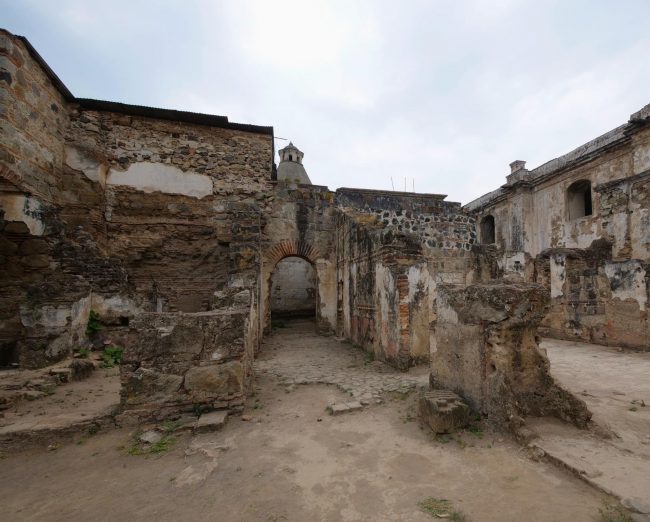
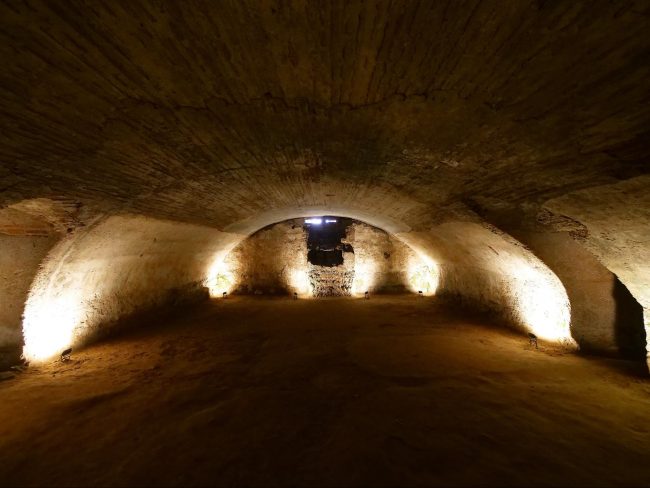
The facade of the cathedral is still standing but entrance is through the side door. At night, the facade is lit making it look magical, almost like a ghost building, not far from the truth.
Antigua Guatemala Cathedral is part of this full day tour of Antigua Guatemala together with all the other main tourist attractions in Antigua Guatemala and a tour of the coffee plantation I mention in this article. Book it here.
Convento Santa Clara
The convent was founded by Claris nuns from Puebla in Mexico in 1700 and the original convent had a tiled roof that collapsed with the 1717 earthquake, after which, the convent had to be completely refurbished and reopened in 1734 with a new look.
Originally, the convent was first sponsored by María Ventura de Arrivillaga Coronado and expanded to include a church which was manned by the Franciscan order.
Because the nuns were cloistered and did not leave the convent, the church’s facade is inside the convent and is built in the Baroque style. The convent had cells for 46 nuns but was founded by six.
Like with all other structures in Antigua Guatemala, Convento Santa Clara was destroyed during the earthquake of 1773, which forced the nuns to move to Guatemala City, and in 1874 the building’s dome collapsed.
In the same year, the nuns, and all other religious personnel, were finally expelled from Guatemala by the government. What was left of the convent was then hit by the 1976 earthquake.
Today you can see the ruins of the convent with its cloister and the remains of the church. Colors and details are lacking, but the space preserves the beauty of the structure. You can go up the first floor for views from above and of the surrounding volcanoes.
The gardens of the convent are a nice place to come have some rest and it is common to see local families having a picnic on the green grass around the main fountain. You can also rent the space for weddings.
Iglesia de San Francisco
The white Church of San Francisco is one of the most interesting places to visit in Antigua Guatemala because it is relevant not just from an architectural point of view, but also from a historical one.
The church and convent were first founded in 1542 but damaged by the 1565 earthquake and reopened in 1578 with an expanded footprint, only to be damaged again in 1679.
After renovations, the temple was finally consecrated in 1714, with a Baroque facade typical of Antigua Guatemala. At its peak, the convent was one of the largest in Antigua Guatemala and had 80 monks.
Today, San Francisco Church is home to the remains of Pedro de San Jose de Batacur, colloquially known as Hermano Pedro (Brother Peter) and Central America’s first saint, beatified in 1980 and canonized by Pope John Paul II in 2002, who then canonized Mexico’s Juan Diego Cuauhtlatoatzin.
Pedro was originally from the Canary Islands, in Spain, which his father, famous knight Jean de Béthencourt, conquered for the Spanish King Henry III of Castile in the beginning of the 15th century.
His tomb was kept in a chapel inside the church from 1897 until 1991 when his remains were moved to the church’s transept in what is known as the Sanctuary of Brother Peter of Saint Joseph de Betancur.
The sanctuary receives a constant stream of visitors throughout the year, with pilgrims coming to light candles, pray and drop their pleas in a glass box by his remains, one of the most popular things to do in Antigua Guatemala.
During Holy Week, San Francisco is home to one of the most important brotherhoods and hosts the famous sculpture of Christ of Nazareth and the Virgin Mary, both of which are on display when the procession is not on.
San Francisco Church is part of this full day tour of Antigua Guatemala together with all the other main tourist attractions in Antigua Guatemala and a tour of the coffee plantation I mention in this article. Book it here.
Palacio de los Capitanes Generales
This imposing building flanking one side of Plaza Mayor is The Royal Palace also known as Palacio de los Capitanes Generales, or Palace of the General Captains, and this is where several of the government dependencies were located, from the prison to the police headquarters.
The earthquakes of the 18th century that destroyed Antigua also badly damaged the palace which was only renovated toward the second half of the 19th century when it housed the police and the political powers again.
But the earthquakes of the 20th century damaged it again and one of the facades fell through.
Hotel Casa Santo Domingo
This luxury hotel in Antigua Guatemala, the only 5 star hotel in the city, is housed in a convent and church of the Dominican Order and is also the location of a couple of museums and several archeological finds which are open to non-guests.
Santo Domingo Convent was founded in 1551 but the church dates from almost a century later. The convent also had a school devoted to Santo Tomas de Aquino and a set of ten double bell towers which followed a clock brought to the Americas in 1553.
Sadly, the convent was heavily damaged by the 1717 earthquake and then completely destroyed and abandoned in 1773.
Because of the quality materials with which the convent was built, it was unfortunately used as a quarry for many other constructions in Antigua Guatemala, including a school which was housed in its atrium.
Thankfully, Convento Santo Domingo was rescued by Edwin Shook and his wife who renovated part of it and founded an archeological center nearby. The property was finally sold to Protunac who turned it into Antigua Guatemala’s finest hotel.


On the site there are several museums arranged along the Paseo de los Museos, or Museums Promenade, in what once was the church, convent of Santo Domingo and Santo Tomás de Aquino College.
The route is drawn on a convenient map available when you buy your tickets and there are lots of signs and explanations along the way. While this is the most expensive attraction in Antigua Guatemala it is also the best maintained and the one with the most information provided, especially to English speaking visitors.
You can explore the Museum of Pre-Columbian Art and Modern Glass which is located in some of the convent’s rooms and has objects and artefacts dating back to pre-Columbian time including Mayan masks, bowls, etc.
The Colonial Museum and Archeological Museums are fantastic and host a range of paintings and sculptures. You can also descend to the crypt where human remains and tombs were uncovered.
The Marco Augusto Quiroa and the Artists Hall, the Silver Museum and the Pharmacy Museums complete the Museums walk.
The hotel also has a small chocolate factory and a candle making workshop where you can learn more about how chocolate and candles are made, they also sell both.
Even if you don’t visit the museum part, the hotel is a great place to come for a drink or for dinner, their fine dining restaurant is one of the best in the city and has a good wine list too.
Casa Santo Domingo is part of this full day tour of Antigua Guatemala together with all the other main tourist attractions in Antigua Guatemala and a tour of the coffee plantation I mention in this article. Book it here.
Santa Catalina Arch
The most famous of the images of Antigua is the colonial arch of Santa Catalina in the center of the city, and a photograph here is a popular thing to do in Antigua Guatemala.
The street that crosses the arch is also the most popular of the landmarks in Antigua and it is always full of people taking pictures.
The arch was in fact a passage that connected the two sides of the Convent of Santa Catalina so that the cloistered nuns could cross without being seen. The arch has withstood the many earthquakes and volcanic eruptions that have hit Antigua through the centuries.
Pro tip: While the Arch is almost always full of people taking all sorts of pictures, especially during the busiest time of the year, during Easter, the Arch is relatively quiet in the morning before 8am so you can have it all to yourself.
Antigua Guatemala Central Park or Plaza Mayor
Plaza Mayor, known in English as Central Park, is the heart of Antigua and the place to come for people watching.
There are street stalls, children running, families and friends gossiping and chatting, and generally taking in the atmosphere.
Around the square you can find Antigua’s most sober and imposing government buildings and in the middle, the Fountain La Gomera.
Places to see near Antigua Guatemala
A lot of people travel to Antigua Guatemala with the idea of basing themselves there, partaking in all the things to do in Antigua Guatemala and then taking day trips to all the nearby attractions and sights.
This is for sure possible and a smart move, because Antigua Guatemala is very well located in the middle of the southern part of the country and there are lots of buses going to all the nearby places, tourist companies who can take you there and good roads.
Here are a few places to visit nearby that should make the list of things to do in Antigua Guatemala as perfect half or full day excursions.
Hobbitenango
A play on words from Hobbit and Acatenango, Hobbitenango is a hobbit village one hour from Antigua Guatemala, weird much?
I think so too, but hey, it makes for a really fun thing to do in Antigua Guatemala and gives you the chance to drive up the mountains for an amazing view. There is a restaurant on site, as is a hotel, so you can come for lunch.
Iximche
I actually started my Guatemalan trip at Iximche, the second most visited site in Guatemala after Tikal, because it was conveniently on my way to Atitlan Lake.
Iximche is a Kaqchikel Mayan archeological site located about 1,5h drive north of Antigua Guatemala, up in the mountains and near the town of Tecpan.
Translated as arbol de maiz, or corn tree, Iximche belongs to the post-classical 900 – 1,400 AC Mayan period and was the capital of the Katchiquel Kingdom.
At its peak, 300 people belonging to four noble families lived in the city and dominated over a population of 40,000 inhabitants that expanded to Chichicastenango.
The city was surrounded by ravines which gave it a strategic and safe location, until the arrival of the Spanish that is. Access to the city was done through a bridge.
At the entrance of the site there is a Mayan Stellar that was built to commemorate the year 2000, or the Mayan year 13 Mactum, and talks about the origin and decline of Iximche.
The site is divided into four areas, one for each of the noble families which inhabited Iximche. The further away from the entrance the smaller and less excavated the site is, and the less powerful the family. The more powerful families had larger land ownership.
The last part of the complex is not excavated and covered with trees. This is still used for Mayan ceremonies, in fact there was one ongoing when we arrived. Ceremonies last about an hour and include singing, praying and offerings.
Iximche was founded in 1465, 600 years after Tikal, so it was a modern Mayan city when the Spanish arrived and attacked it in 1524.
What you can see today when you visit Iximche is the stone remains of the city as the majority was made of perishable materials which were burnt down by the Spanish.
Each square has three temples, one devoted to the Sun, one to the Moon and a third one to the Wind. There is also the base of the palace where the family used to live and several altars are perfectly oriented towards the north.
The first family was the only one with two squares within its area and had a much larger space. You can also see two ballcourts inside the city, typical of the Mayan culture, the first one was excavated and is pretty well preserved.
The Mayans were knowledgeable mathematicians and had their own calendar. Across the site you will note several references to the number 20, the Mayan numeral system, and other references to the number 13, an important number in the Mayan culture.
If you multiply 13 by 20 you get 260 which is the number of days in the lunar calendar used by the Mayans, it is also the time it takes for corn to grow or roughly the number of days from conception to birth.
Fun fact: Did you ever notice that the Mayan pyramids had narrow and steep steps? These were not meant to be climbed facing straight but sideways, walking up in a diagonal line towards the sun.
There is a free museum at the entrance to Iximche which tells you more about the city, its history and the Katchikel people, although it is in Spanish. The artefacts found on site are also exhibited there although the majority are in the archeological museum in the capital.
You can hire a local Katchiquel guide, to take you around the site, like I did, and it is well worth it. The tour lasts about 45min and you can then stay for as long as you like.
I paid 125 Quetzal (about $15) which is not cheap but pretty reasonable for a guide. He was incredibly knowledgeable and told me that there are also guides who can give the tour in English.
Atitlan Lake and the shore villages
Atitlan Lake is a beautiful part of Guatemala and one of the best places to visit from Antigua Guatemala.
You can spend a few days there but if you don’t have time and want to go explore for a day, this day tour from Antigua Guatemala will take you to see the three main towns, Santiago Atitlan, San Pedro and San Juan La Laguna, on the lake’s shore and is the perfect sample of life on the lake.
You will also stop at Panajachel, which is a colorful town and the starting point for all the lake’s exploration. Here you can buy any souvenirs from the many shops.
Guatemala City
Guatemala City does not get great rep and is usually avoided by most. Visiting Guatemala usually means traveling to Antigua Guatemala, Tikal and Atitlan Lake and skipping the capital altogether.
Truth be told, I spent two days in Guatemala City and did not find much to do or see, so half a day tour is probably the best way to see the highlights of the city including the main square and church and a few other landmarks including the two main museums. Book it here.
Tikal
Guatemala’s main tourist attraction is Tikal.
This Mayan archeological site is the country’s most visited place and it does not surprise me that it ranks number one. While the southern parts of the country are more important for later constructions and for colonial times, Tikal is the oldest and most typical of all the Mayan ruins.
However, it is perfectly possible to visit the country and not go to Tikal because it is far and disconnected from the rest of the country, and closer to Belize City than to Antigua Guatemala.
I considered driving but the drive would be really long and there were not a lot of stops on the way. The majority of visitors to Guatemala go to Tikal on a day or overnight tour, departing early in the morning and returning in the evening.
Flights to Flores, the closest airport to Tikal, depart before 7am and return in the mid afternoon so they are perfect for this and illustrate the type of visitor to Tikal.
If like me you prefer to do that, you can book a day tour to Tikal with flights, entry tickets, transport from the airport to the ruins (it is a 1h drive) and guide here.
Copan
Copan is another great Mayan site that is actually closer to Antigua and El Salvador than it is to Tegucigalpa or San pedro Sula.
Tour operators offer day trips to Copan which give you the chance to visit the ruins and return on the same day. Beware that this is a long drive but it is the best way to see this site, Honduras remains quite a dangerous place to visit.
Places to eat and drink in Antigua, Guatemala
Antigua Guatemala is a great foodie destination to try Guatemalan food and also any other type of international cuisine.
Remember the chocolate and coffee I mentioned earlier? That is right, eating is one of the best things to do in Antigua Guatemala, trust me.
The area is fertile and vegetables and fruits thrive so everything you will eat will most likely be grown nearby. That also means that fish is less common, as the sea is further away, but still found.
The hipster crowd has also made it to Antigua Guatemala and you will not be short of specialty coffee shops, vegan restaurants and acai bowls. Here are some recommendations for places to eat in Antigua Guatemala.
- GuateJava: This cafe is a great place to come have a good cup of coffee from locally grown beans. More info here.
- Fat Cat Coffee House: A well established local bean roasting and specialty coffee shop brewing the best there is, for real experts. More info here.
- Fernando’s Kaffee: Fernando’s is well known as a good coffee and chocolate destination. He is one of the pioneers in the chocolate industry boom in Guatemala in recent years and the push to keep the profits from processing the beans into chocolate in the country. More info here.
- Dona Luisa Xicotencatl: A typical, casual and laid back place to taste homemade Guatemalan food. More info here.
- Rincon Tipico: Owned by the same people behind Caoba Farms, Rincon Tipico is one of the most famous restaurants in Antigua Guatemala and for good reason. Always packed and serving lovingly made casual local favorites. Try it for breakfast too. More info here.
- Antigua Brewing Company: There is a local microbrewery in Antigua which also runs a bar with a rooftop, live music and lots of character. Come to try a flight of their beers which will give you chance of tasting five types from lighter to stronger. More info here.
- Los Tres Tiempos: A super colorful place that modernizes the local flavors of Guatemalan cuisine in a bright space right by El Arco. I loved every bit of this place so much I wanted to return. Fun fact: Los tres tiempos refers to eating tortillas which are usually eaten at all times, or all three times, meaning breakfast, lunch and dinner. More info here.
- Fridas: Another institution right by Los Tres Tiempos and a tribute to Frida Kalho. As expected, her colorful works are on display and there are many quirky objects around, live music and Mexican food. More info here.
- Caoba Farms: as mentioned above, one of the best in town with the freshest ingredients and the most laid back atmosphere, recommended for breakfast or lunch in particular. More info here.
- Meson Panza Verde: a fixture in the refined dining list of Antigua Guatemala, this is the most awarded local restaurant and has received many accolades. Try their cocktails while you wait for your table. More info here.
Best hotels in Antigua Guatemala
There are a lot of hotels in Antigua Guatemala and it is pretty difficult to choose because they all look the same.
The best hotel without a doubt is the Hotel Casa Convento Santo Domingo, set in a renovated convent, church and school this is the ultimate in luxury in the city.
Book now on Agoda | Booking.com
If Santo Domingo is beyond your reach, try Pensativo House Hotel where I stayed at, which is a nice 4 star hotel in the southern part of the city, and it has a nice restaurant, manicured gardens and courtyards and pleasant rooms. There is a parking lot across the street which is complimentary for guests.
Book now on Agoda | Booking.com
For another beautifully restored colonial building, Meson Panza Verde also has rooms and is delightful if much cozier.
Book now on Agoda | Booking.com
For something a bit more interesting try Filadelfia Coffee Resort and Tour which is a bit far from town, but offers free shuttles and makes for a nice walk down. The rooms in the coffee plantation amidst nature make for a welcoming change.
Book now on Agoda | Booking.com
All you need to know before your travel to Antigua Guatemala
There are a few things you should know before traveling to Antigua Guatemala.
Safety in Antigua Guatemala
Guatemala is much safer than other Central American countries such as El Salvador or Mexico but you should still make sure to have your eyes wide open at all times.
In particular, the small towns around Lake Atitlan and the volcanoes are known as theft prone places where tourists get robbed, oftentimes with a gun pointed at them.
Antigua Guatemala is however the safest part in the country thanks to its status as a UNESCO site and a major tourist destination so you should feel much safer here. I had no issues walking around on my own but I would recommend minimizing that at night, like anywhere else.
Cash and credit cards
As an eminently tourist destination I was expecting cash and credit cards to be accepted equally in Antigua Guatemala yet cards are not widely accepted and cash is king. Which brings me to the next issue.
I did not manage to withdraw cash at any of the ATMs in the country despite multiple trials at every single ATM that I saw so I had to resort to getting cash against my credit card at a currency exchange house. Needless to say that was the most expensive commission I have ever been charged, over 20%.
I could not even figure out why I was not able to get cash, my card was a regular one from Citibank and I have used it in every single country, and I never heard anything from my bank either, just the ATM telling me “the operation cannot be completed”.
Lessons learned, bring cash to Guatemala, lots of it. The country, and Antigua in particular, are not cheap, and for a destination that should be affordable, you will find yourself spending $10-20 per meal easily.
Driving in Antigua Guatemala
I drove on my own during my time in Guatemala and never had any issues.
The roads are in good condition and there are signs everywhere. Google maps generally gets it right although it did take me down and up streets that were one way only or which were not passable (yep, a couple of times I tried to drive up a street that the car could not climb, true story).
I felt the same way as when I was in Berat (or anywhere in Albania really) and Google Maps took me through such narrow streets the car’s mirror eventually got hit by a street lamp, it was the lamp or us.
Best time to visit
Antigua Guatemala is never too hot or too cold. Sitting at 1,500m above sea level the temperatures can be quite chilly at night when a sweater will be useful.
You should try to avoid the rainy season which runs from May to November and when a lot of the country becomes impassable and prone to slides. This will also make your excursions harder, climbing the volcanoes practically impossible and visiting the main outdoor sites impractical.
Apart from the rainy season, Easter is an important time of the year and, while it is a fascinating time to visit, you need to be aware that it poses complications. Prices are higher, hotels are booked out, traffic jams are non-stop because of street closures are a common daily issue and you could be stuck without the possibility to explore outside the city – so weigh pros and cons.
How to dress and what to pack
While quaint and authentic, the cobblestone streets of Antigua Guatemala are pretty hard to walk on so make sure to wear closed shoes, flip flops are dangerous because you could twist an ankle and flats shoes with thin soles will make your feet ache.
Even on a sunny warm summer day Antigua Guatemala is never super hot and when the sun is not shining it can get chilli so bring a sweater.
If you plan to hike the volcanoes, you should ideally bring a thin raincoat (it rains often at the top), a long sleeve t-shirt (it gets chilli at the top) and long trousers. Hiking boots are useful but not essential, trainers will suffice.
A small backpack is useful to carry your stuff, water and snacks to the top. And remember that whatever you wear to the volcano will be filthy and useless afterwards due to the black dust.
A hat or cap is useful to protect from the sun, even on a cloudy day, and sunscreen, lip balm and sunglasses are a must. I never leave the house without them.
- Check if you need a visa, get help processing it at iVisa.
- Never ever leave without travel insurance. Get affordable coverage from World Nomads or long term insurance from Safety Wing.
- I find all of my flights on KAYAK. Check their Deals section too.
- Search for all your transportation between destinations on the trusted travel booking platform Bookaway.
- I book all my day trips and tours via GetYourGuide, they are the best and their tours are refundable up to 24h in advance.
- Get USD35 off your first booking with Airbnb.
- Compare hotels EVERYWHERE at HotelsCombined and book with Booking.com.
- Compare car rental prices at Rentalcars.com

